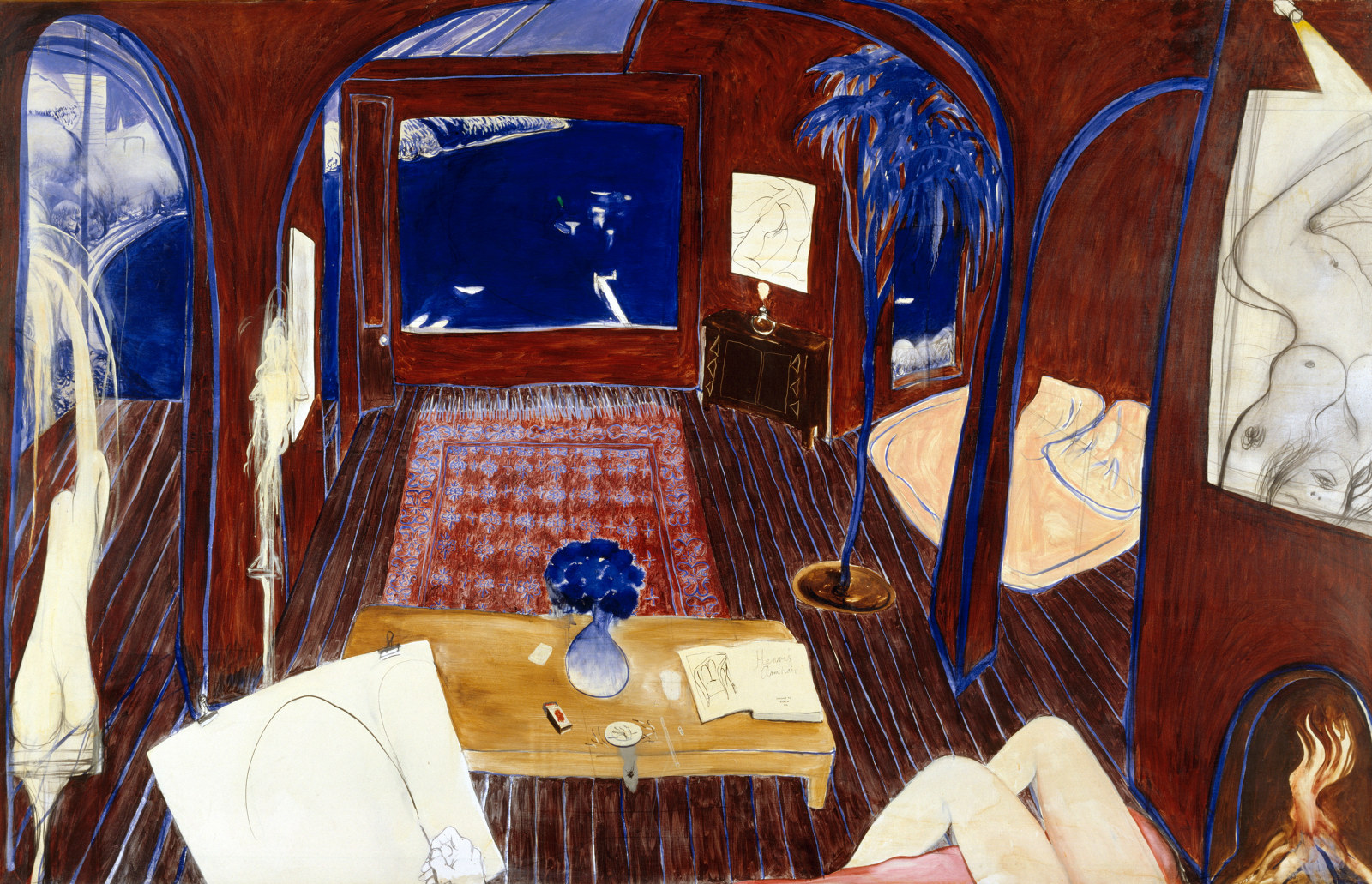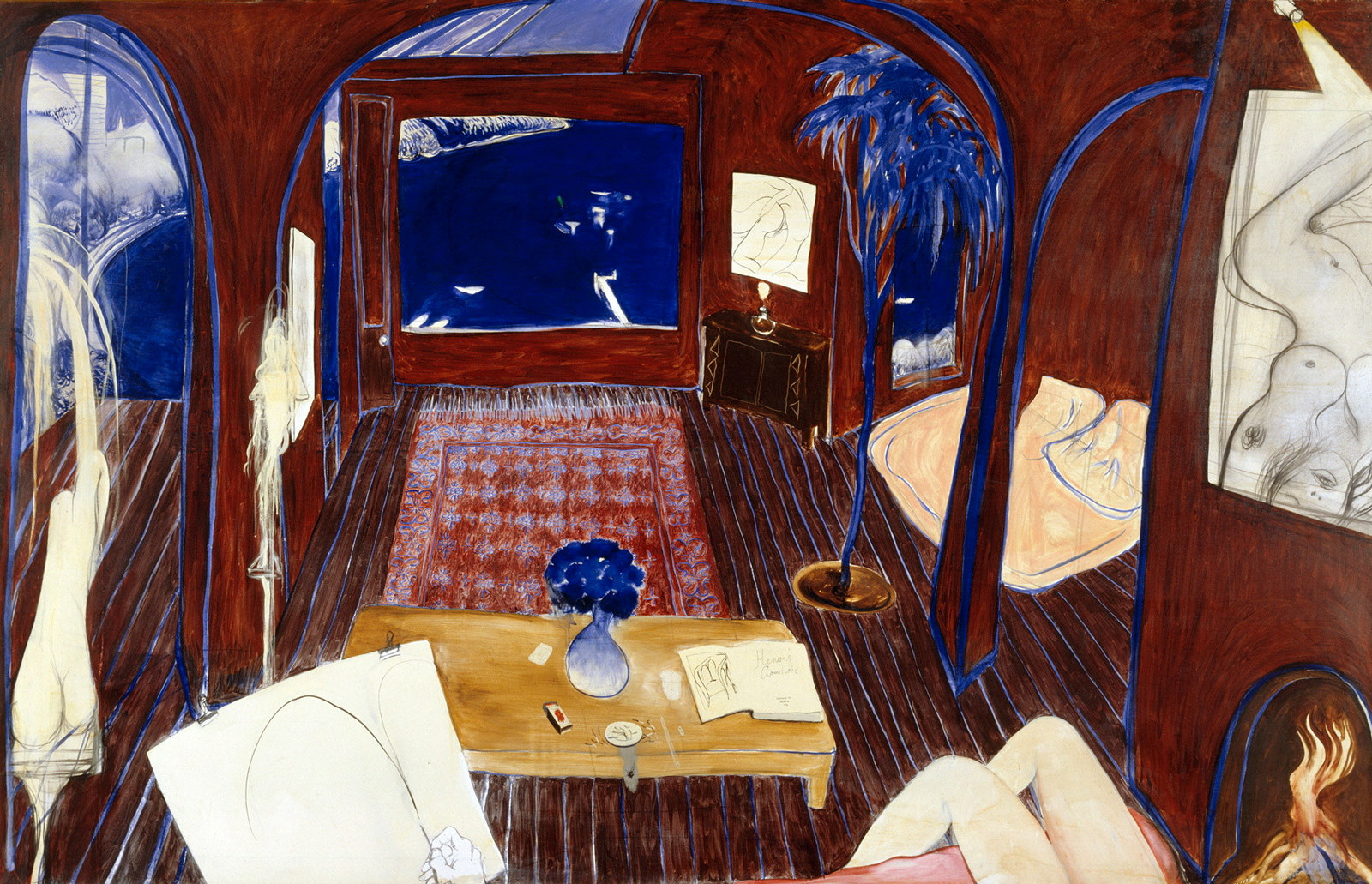Lavender Bay, 1974
In early 1974, Tom Carment moved into a flat in Lavender Bay. The young artist took odd jobs to pay the rent, and found inspiration in his vibrant surroundings.
The sounds I remember from 1974 are those of the night: the clatter and screams from the Big Dipper at Luna Park, the thump of a ferry bumping the wharf below, and, often, loud music from the house next door, voices singing along to the hook lines of songs by Bob Dylan, Tim Buckley, Van Morrison … ‘Forever young’, ‘Sweet surrender’, ‘Into the mystic’ … and sometimes, at 3am, loud arguments.
For most of that year I lived in the downstairs flat at 3 Walker Street, which consisted of three rooms next to Clark Park, 50 steps above the railway and the Lavender Bay ferry wharf. I could paint looking out from my small verandah. There was a thicket of coral trees growing on the railway land below the park, their red flowers so vivid in August. A friendly couple, aged in their late thirties, lived for a while upstairs with their ten-year-old daughter. They were followers of Divine Light, a movement whose guru was a chubby teenager, Maharaj Ji. They ate vitamised fruit and vegetables and went on cleansing fasts. Their daughter would get me to sneak her Paddle Pops from the corner shop. She used to play with Arkie Whiteley, who lived in the house next door with her parents.
A lively atmosphere
In 1974 I was 19 and, after a year at Julian Ashton’s Art School in The Rocks, I’d decided that I was ready to go out into the world, find part-time work and paint my own pictures. In my new flat I prepared boards and canvases, playing an LP of Mahler’s Das Lied von der Erde over and over. I had no telephone and made arrangements by letter, the urgent ones by telegram.
I wasn’t completely alone in my endeavour, having older artistic mentors who lived on the NSW North Coast, and I’d also become friends with the poet Robert Gray. In a letter to him from mid-1974 I wrote: ‘Later this week I start work, painting the Whiteleys’ house … the atmosphere should prove to be lively’.
Lots of energy and not much skill
A man called Terry Stanton had been supervising the renovations at 1 Walker Street, which the Whiteleys were converting from flats back into a single residence. Terry was a spinning wheel of enthusiasms, and handsome like a young Harrison Ford. He’d replaced most of the upstairs walls with low Moroccan arches. Downstairs, where the artist Rollin Schlicht and his partner Diana had previously lived, became Brett’s new studio. Terry employed his hairy mates to do the work, and I guess I was one of them, with lots of energy and not much skill. Where a Hills hoist had once stood in the triangular front yard, a swimming pool was sunk. I think it was Terry who told me that Brett had offered the pool builder a painting of a swimming pool in exchange for the cost of its construction.
While I was working there, a steady stream of people came through the house. Channelling Matisse on the Côte d’Azur, Brett did a large painting of the new upstairs interior with all its arches, and hung it on the fresh white wall. I recall the artist Victor Rubin standing before this painting with a sketchbook. He corrected the perspective, tore out the page and gifted it to Brett. William Yang, camera around his neck, long black hair middle‑parted, introduced himself at the bottom of my ladder.
The visitors were orchestrated by Wendy, their conversations fast-flowing and often hyperbolic, and sometimes a bit competitive. When Brett got bored with someone he would cut them off mid‑sentence with a ‘yeah, yeah’ and walk away.
Hair of the dog
One morning I arrived at work to find everyone in the kitchen, looking tired, and drinking tumblers of a milky liquid that smelt like aniseed.
‘What’s that?’ I asked. ‘A health tonic’, replied Wendy in a husky voice, laughing. Wendy was kind to me, and protective.
Receiving advice
There was still a big studio at the old gasworks in the next cove, used by Brett for large works and storage. You could take a shortcut there by walking illegally through the dark railway tunnel; my heart would pump until I saw the pinprick of light reappear. Tim Storrier was sharing the studio, calmly painting a series of big outback scenes, aerial views, the land speckled with small cloud shadows. Brett’s painting methods were much more Sturm und Drang: throwing turps at his canvas to get a flow going, then zeroing in on details, dancing back and forth.
Brett looked at my paintings a couple of times and made useful, encouraging comments. Away from the clamour, he had a thoughtful and generous nature. My paint application was ‘a bit toothbrushy’, he reckoned.
I also visited the artist Max Miller, who lived in a dark brick house near Stanton Library in North Sydney. Soft-spoken and patient, Max showed me how to cut good mitres for my frames, and mix certain colours. Cerulean blue and chrome oxide green, he told me, were a subtle combination.
Twice in 1974, I travelled up the North Coast to stay with the painter Ted Hillyer and his family in their house among the dairy paddocks. Ted, who lived modestly, away from city lights, was unimpressed by the glitz of the Whiteley scene and warned me not to be a moth to its flame.
Moving on
On my return from one of these trips I found my verandah door open, banging in the breeze. Terry had needed to break in to show a prospective buyer my flat. An artist called ‘Kingo’ (Peter Kingston), just home from overseas, would soon purchase 3 Walker Street. I was given friendly notice and moved on with no regrets. Terry discovered a disused shipping warehouse in Balmain that I could rent, its interior stacked with dusty wooden pattern dyes.
Just before I left Lavender Bay we got together for a working bee, cleaning out a lot of rubbish from among the coral trees. Their red flowers had turned to mush underfoot. The whole hill seemed to be made of bottles. Many years later, after much work (and after I had moved on), this park would be known as ‘Wendy’s garden’.
Author
Tom Carment, painter and writer
Tom Carment won the 2008 Gallipoli Art Prize and the 2014 NSW Parliament Plein Air Painting Prize. His book, Seven walks (with photographer Michael Wee), was published in 2014.
Published on
Related

Past exhibition
Bohemian Harbour: Artists of Lavender Bay
The spectacular views from Sydney’s Lavender Bay have inspired generations of artists who have celebrated its great beauty

About Bohemian Harbour: Artists of Lavender Bay
With its sweeping views across the sparkling water to the city skyline, Lavender Bay on Sydney’s lower north shore has inspired generations of artists

In conversation with Wendy Whiteley
Wendy Whiteley OAM talks about the significance of Lavender Bay in her extraordinary life as wife, muse, mother, and creator of a much-loved garden